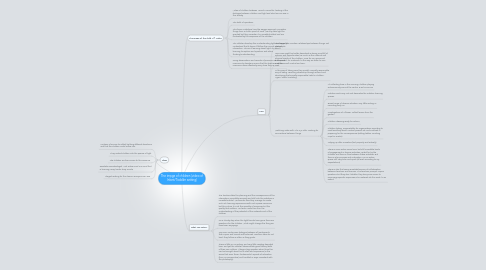
1. Ideas
1.1. Curtains of mirrors to reflect lighting different directions and that the children could move into
1.2. They invited children into the spaces of light
1.3. The children are free access to this resource
1.4. Rizzolate-neurobiologist. And active mind is a mind that is learning. Busy hands, busy minds!
1.5. Staged seating for the class so everyone can see
2. The image of the child. T2. Video
2.1. Video of children between 12and 18 months, looking at the dialogue between children and light and what we can see in this activity
2.2. The birth of questions.
2.3. This focus underlines how the Reggio approach considers things from a child's point of view. We may take light for granted but they consider it in incredible detail and are motivated by the responses of the children.
2.4. The children develop thie understanding light and begin to understand that it doesn't ffollow the normal rules of interaction. This isn't learning about light, it's about learning to explore and question and refine thinking/understanding.
2.5. Using observations and records of previous use of specifi resources by teachers ensure that the teachers use the resources more effectively every time they re used.
3. What you notice.
3.1. The teachers take the planning and the consequences of the interactions incredibly seriously and drill into the activities in incredible detail. We wonder how they manage to create such rich learning experiences with such sparse resources, but this is how. It's not the quantity of resources but the quality that matters. And even more than this, the understanding of the potential of the materials and of the children
3.2. On a cloudy day, when the light friends have gone there are questions for the children. What might change the thing we have been enjoying?
3.3. You see a continuous dialogue between all participants that's open and honest and balanced. Teachers here do not lead, they follow as often as they guide.
3.4. There is little or no writing, and very little reading depicted here, and yet the children demonstrate good literacy skills of their own volition. It begs a big question about how this can be brought about but is stark and impressive (in the sense that even these 'fundamental' aspects of education (from UK perspective) and handled in ways consistent with the philosophy).
4. Care
4.1. The capacity to maintain relationships between things, not just people
4.2. Here care might be better described as being mindful (of options and opportunities) as much as the notional and physical needs of the children. Care for our space and environment, for materials, to the way we listen to one another as well as what we learn.
4.3. In this way of taking care they model a socially responsible way of being. Teaching citizenship through actions and developing that socially responsible habit in children. Again, rather humbling.
4.4. Watching video with 3 to 6 yr olds. Looking for connections between things
4.4.1. At collecting time in the morning, children playing autonomously around the centre. 8.00 to9.00 am
4.4.2. Outdoor work very rich and decorates the outdoor learning spaces.
4.4.3. Broad range of diverse activities, very little writing or recording early on
4.4.4. Investigations of a flower: collect leaves from the garden
4.4.5. Children dressing ready for action!
4.4.6. Children taking responsibility for organisations reporting to cook/auxilliary about number present etc and involved in preparing for the consequences (setting tables, counting cups for snacks)
4.4.7. Tidying up after ourselves (but properly and actively)
4.4.8. There is more active noise here, but still incredible levels of engagement in diverse activities, opted for by the children and there is flow between these activities. But there is also purpose and motivation. For an active space, still very calm and quiet (at least according to my expectations)
4.4.9. There is also that same remarkable sense of collaboration between teachers and learners. The teachers prompt, inspire questions but they don't dictate, they barry even seem to encourage specific responses! The materials do this work, to an extent.
